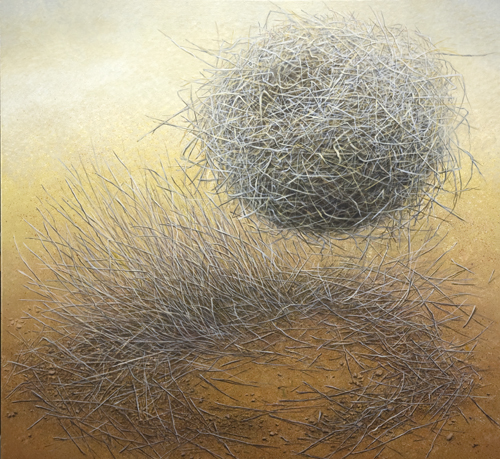Circularity
brushland 2010
Remarks by Hanna Kay and Response by Ross Mellick Hanna Kay - When not in conversation with the canvas I have a chat with the natural world around me. It seems that there isn't a shape in nature that affects me like the circle or the circular. A stalk blowing in the wind forming a circle-like shape in the sand. A pile of gathered leaves, trapped by the wind, whirling just above the ground. The weather turns large rocks into smaller stones, and then into pebbles and finally into sand grains that in time will turn into sandstone. I am happy when I make circles in the grass, and I found out that the more I painted circles the happier I became. Circle: a closed curve divides the plane into two regions - an interior and an exterior. The idea of concave/convex intrigues me. The very same line that creates concave automatically creates convex, two opposites, each existing by virtue of the other. Ross Mellick - Taking notice - paying close attention to what is happening in the immediate and more distant environment is a crucial part of the creative process almost irrespective of the type of art ultimately created. Here, particular sensitivities are described by Hanna which return to inhabit the two dimensional surface of her completed paintings. The opaque white tempera which she layers meticulously assists to define the shape of the forms in her paintings but, more importantly, it reflects light which, in turn, is modulated by layer upon layer of partly transparent oil paint, creating with great subtlety light effect and colour tones, as in nature. Her rigorous technique achieves subtle and beautiful images of the natural world and also serves another purpose, creating works for the perceptive viewer which act as metaphors alluding, through the subjects of dry grass, twigs, sand, stones and shallow water, to day to day experience. The works successfully achieve a nexus of awareness about the almost immeasurable age of the natural world, with co-existing awareness of the fragility and transience of human perception on which that experience is dependent. Human footprints in the sand blow away with the next gust of wind. The works are realistic in so far as there is no ambiguity of subject matter: grass is grass, twigs are twigs, and sand is sand. However the works also successfully invite extension from a celebration of the world at large into engagement with being and other metaphysical dimensions. |
